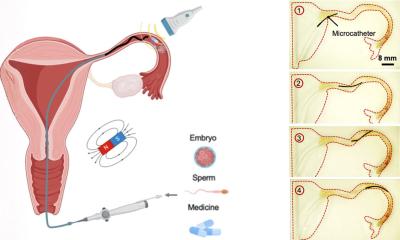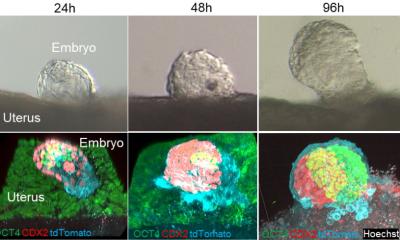News • Reproductive medicine study
Seeing double: Why there are more twins than ever
More human twins are being born than ever before, according to the first comprehensive, global overview published in Human Reproduction, one of the world’s leading reproductive medicine journals.

Since the 1980s the twinning rate has increased by a third from 9 to 12 per 1000 deliveries, meaning that about 1.6 million twins are born each year worldwide and one in every 42 children born is a twin. The study finds that a major cause of this increase is the growth in medically assisted reproduction (MAR), which includes not only IVF (in vitrofertilisation) techniques, but also simpler methods, such as ovarian stimulation and artificial insemination. Another cause of the increase is the delay in childbearing observed in many countries over the last decades, since the twinning rate increases with the mother’s age.
However, the researchers think that we may have reached the peak in twinning rates, particularly in high income countries such as Europe and North America, because of increasing emphasis on the importance of trying to achieve singleton pregnancies. Whether this is also the case in lower income countries, such as Africa, is less certain and has important implications for the health of mothers and babies, and also healthcare resources.
Recommended article

News • Fertilisation
IVF: Why a single embryo sometimes leads to twins or triplets
It has been known for some time that it is better to transfer a single embryo to a woman’s womb during assisted reproduction treatment (ART) to avoid a multiple pregnancy. However, even when single embryo transfer (SET) is performed, some women still become pregnant with twins or even triplets. Researchers have investigated one of the reasons why this happens.
Professor Christiaan Monden, of the University of Oxford (UK), the first author of the study, said: “The relative and absolute numbers of twins in the world are higher than they have ever been since the mid-twentieth century and this is likely to be an all-time high. This is important as twin deliveries are associated with higher death rates among babies and children and more complications for mothers and children during pregnancy, and during and after delivery.”
Prof Monden and his colleagues, Professor Gilles Pison of the French Museum of Natural History in Paris (France) and Professor Jeroen Smits of Radboud University (The Netherlands), collected information on twinning rates for the 2010-2015 period from 165 countries, covering 99% of the world’s population. For 112 countries, they were also able to obtain information on twinning rates for the period 1980-1985. They found substantial increases in twinning rates in many European countries, in North America and in Asia. For 74% out of the 112 countries, for which data were available for both periods, the increase was more than 10%. There was a 32% increase in Asia and a 71% increase in North America. A decrease of more than 10% was found in only seven countries.
Prof Monden said: “In both periods Africa had the highest twinning rates and there was no significant increase over time. However, Europe, North America and the Oceanic countries are catching up rapidly. About 80% of all twin deliveries in the world now take place in Asia and Africa. The twinning rate in Africa is so high because of the high number of dizygotic twins born there – twins born from two separate eggs. This is most likely to be due to genetic differences between the African population and other populations. The absolute number of twin deliveries has increased everywhere except in South America. In North America and Africa, the numbers have increased by more than 80%, and in Africa this increase is almost entirely caused by population growth.”
We might see a combination of lower overall fertility, older ages at birth and more medically assisted reproduction
Gilles Pison
Most of the increase in twinning rates comes from dizygotic twins, while there has been little change in the rate of monozygotic twins (twins from the same egg), which has remained stable at about 4 per 1000 deliveries worldwide. Evidence from the study suggests the increasing availability and use of MAR is the main cause of the increase; it started in the wealthier countries in 1970s and spread to emerging economies in Asia and Latin America in the 1980s and 1990s, reaching more prosperous parts of South Asia and Africa after 2000. Women choosing to start families later in life, increased use of contraception and lower fertility overall also play a role.
According to Prof Smits, the study has important implications, particularly in respect of the growth in twinning rates in low and middle income countries. “Because infant mortality rates among twins have been going down, many more of the twins born in the second period of our study will grow up as twins compared to those born in the early 80s. However, more attention needs to be paid to the fate of twins in low and middle income countries. In sub-Saharan Africa in particular, many twins will lose their co-twin in their first year of life, some two to three hundred thousand each year according to our earlier research. While twinning rates in many rich Western countries are now getting close to those in sub-Saharan Africa, there is a huge difference in the survival chances.” [Source: Monden et al., Lancet Global Health 2017]
The researchers say that countries need to keep better data on twin births, particular lower income countries where deaths among twins is highest, as reliable statistics are lacking in many places. This is the main limitation of the study. “Most data suggest we are at a peak in high income countries, especially Europe and North America. Africa will be one of the main drivers in the coming decades,” said Prof Pison. “We might see a combination of lower overall fertility, older ages at birth and more medically assisted reproduction. The former would lead to lower twinning rates, the latter two to higher twinning rates. The net effect of these different drivers is uncertain. Due to their size, India and China will also play a major role. In both cases, medically assisted reproduction might increase twinning rates, while further declines in fertility are more likely in India than in China. Again, the net result is difficult to predict. Advances in IVF make it more likely than not that in the future we will see fewer twin births as a result of IVF.” [Source: Pison et al., Population and Development Review 2015]
The researchers plan to update their results with data for the early 2020s to see whether twinning rates have indeed peaked and started to decrease in high income countries, and what will be the effect of the wider spread of MAR in low and middle income countries.
Source: European Society of Human Reproduction and Embryology (ESHRE)
12.03.2021










